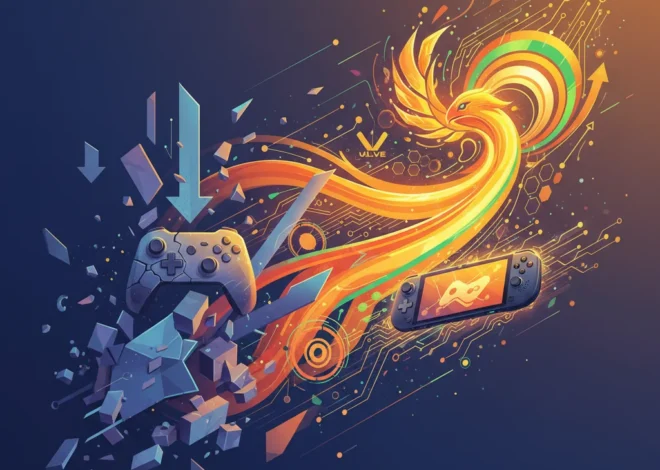
The Ghost in the Machine: How a “Failed” Console Paved the Way for Today’s Tech Innovation
In the fast-paced world of technology, we often celebrate the victors—the disruptive startups that become unicorns, the sleek devices that capture the market. But what about the ambitious failures? The ghosts of projects past often hold more valuable lessons than the runaway successes. Today, we’re exhuming one of the most fascinating ghosts in recent tech history: Valve’s Steam Machine.
You might vaguely remember the buzz around 2013-2015. Valve, the giant of PC gaming and creator of the ubiquitous Steam platform, announced it was taking on the console titans, Sony’s PlayStation and Microsoft’s Xbox. Their weapon of choice was not a single box, but an entire ecosystem of living room PCs called “Steam Machines.” The core idea, as reported by the BBC at the time, was simple yet revolutionary: to bring the vast, open library of PC games directly to your television.
It was a bold gambit that, by most commercial metrics, failed to take off. Yet, to dismiss the Steam Machine as a mere footnote is to miss the point entirely. The project’s DNA is alive and well, influencing everything from handheld gaming to cloud infrastructure and providing a masterclass in long-term strategy for today’s entrepreneurs, developers, and tech leaders. This is the story of how a commercial failure became a catalyst for profound **innovation**.
The Grand Vision: Deconstructing the Walled Garden
To understand the audacity of the Steam Machine, you have to understand the market it sought to disrupt. The console world has always been a “walled garden.” Sony, Microsoft, and Nintendo control the hardware, the operating system, the storefront, and the developer licensing. This closed ecosystem ensures quality control and simplicity for the user, but it also creates limitations and a single point of control (and revenue).
Valve envisioned something different. Their strategy was not to build a single box, but to create a new, open standard for living room gaming. The plan had three core components:
- SteamOS: A custom, open-source operating system based on Linux. This was the software soul of the machine, designed to free Valve and gamers from the licensing fees and corporate control of Microsoft Windows.
- Steam Controller: A radical new gamepad design with dual trackpads, aiming to translate the precision of a mouse and keyboard to a couch-friendly format.
- A Fleet of Hardware: Instead of one “Steam Machine,” Valve partnered with multiple hardware manufacturers like Alienware and Zotac to offer a range of devices at different price points and power levels.
This was a classic platform play, not a product play. For startups and SaaS companies, this is a crucial distinction. Valve wasn’t just selling a box; it was trying to extend its dominant **software** platform, Steam, into a new territory—the living room. The goal was to create an open, competitive hardware market unified by a single software and services layer, much like how various PC manufacturers all run Windows, or how different phone makers use Android.
The AGI Tipping Point: Are We Already Living in the Age of Human-Level AI?
The Technical Hurdle and the Chicken-and-Egg Problem
The vision was brilliant, but the execution hit a massive wall: game compatibility. The overwhelming majority of PC games on Steam were built for Windows. Getting them to run on a Linux-based OS was a monumental challenge in **programming** and software engineering. Valve created a compatibility layer, a precursor to what we know today, but in its early days, it was patchy. Only a fraction of the Steam library worked natively on SteamOS, and many that did suffered from performance issues.
This created a vicious cycle:
- Gamers wouldn’t buy Steam Machines because the library of compatible games was too small.
- Developers wouldn’t invest time and resources porting their games to Linux because the player base on SteamOS was insignificant.
The hardware model, while innovative, also confused consumers. Instead of a simple choice—”Do I buy a PlayStation or an Xbox?”—customers were faced with a dozen different Steam Machines with varying specs and prices. This lack of a clear, unified product message muddied the waters. As a 2015 analysis by Ars Technica pointed out, the complexity and performance gaps made it a tough sell against the plug-and-play simplicity of traditional consoles.
From the Ashes: The Legacy That Powers a New Generation
By 2018, the Steam Machine initiative was quietly shelved. But the work done on SteamOS and Linux gaming compatibility didn’t die. It went back into Valve’s legendary development labs and evolved. This is where the story connects directly to the cutting edge of today’s technology, including **AI** and the **cloud**.
The Birth of Proton: Software-Driven Miracles
The most important legacy of the Steam Machine is a piece of software called Proton. It’s a vastly improved, deeply integrated compatibility layer built into the main Steam client. Using open-source tools like Wine and DXVK, Proton translates Windows-specific commands (like DirectX) into commands that Linux-based systems can understand, in real-time.
This is where modern tech concepts come into play. The process of optimizing thousands of games is a massive data problem. One can easily imagine Valve leveraging **machine learning** algorithms to analyze game performance data across millions of users, identifying bottlenecks, and suggesting automated fixes or optimal configurations. This level of **automation** is what makes supporting a library of tens of thousands of games feasible for a single company. Early reports from projects like ProtonDB, a community-driven data site, showed that over 80% of Steam’s top 1000 games were playable on Linux through Proton (source), a number that was unthinkable during the Steam Machine era.
The Steam Deck: The True Successor
If Proton is the software soul, the Steam Deck is the physical reincarnation of the Steam Machine’s dream. Released in 2022, this handheld gaming PC runs on a new version of SteamOS and uses Proton to play a huge portion of the Steam library. It is, in every sense, what the Steam Machine was meant to be: a single, well-defined piece of hardware that delivers a seamless, console-like experience for PC games.
The success of the Steam Deck, a device that continues to sell out, was built directly on the foundation of the “failed” Steam Machine. Let’s compare the concepts.
| Feature | Traditional Consoles (Xbox/PS) | Steam Machine (2015 Concept) | Steam Deck (2022 Reality) |
|---|---|---|---|
| Operating System | Proprietary, Closed | Open (Linux-based SteamOS) | Open (Linux-based SteamOS 3.0) |
| Hardware Model | Single, unified hardware | Decentralized, multiple partners | Single, unified hardware by Valve |
| Game Library | Curated, platform-specific store | Open Steam store (limited by OS) | Open Steam store (vastly expanded by Proton) |
| Core Value Prop | Simplicity, Exclusives | Openness, Choice, PC games on TV | Portability, Openness, Your entire PC library in your hands |
The table above illustrates the evolution. Valve learned that while an open ecosystem is the goal, consumers initially need a focused, unified hardware product to rally behind. They took the open software philosophy of the Steam Machine and wrapped it in the user-friendly, single-product approach of a traditional console.
Nvidia's CEO Says China Will Win the AI Race. Is He Right?
Lessons for Startups, Developers, and Tech Professionals
The journey from Steam Machine to Steam Deck is more than just a gaming story; it’s a powerful case study for anyone in the tech industry.
1. Embrace the Long Game of Innovation: The Steam Machine project began over a decade ago. It produced no short-term profit but was an invaluable investment in building a strategic moat. For **startups** chasing quarterly goals, it’s a reminder that truly disruptive **innovation** often requires a long, patient, and sometimes costly R&D phase.
2. The Power of a Platform: Valve’s ultimate goal was to protect and expand its Steam platform. By investing in Linux gaming, they created a viable alternative to Windows, reducing their dependency on Microsoft. This focus on platform health over short-term product sales is a key lesson. Whether you’re building a **SaaS** product or a developer tool, think about the ecosystem, not just the feature set.
3. Open Source as a Strategic Asset: SteamOS and Proton are heavily reliant on open-source projects. By contributing to and building upon this foundation, Valve accelerated its development and future-proofed its technology. This also has **cybersecurity** implications; a transparent, open-source stack can be audited by the community, often leading to more robust and secure software than a closed, proprietary system.
4. Data-Driven Pivots: The failure of the Steam Machines provided Valve with critical data on what didn’t work. They learned that consumers wanted a clear value proposition, not a confusing array of choices. This data, combined with years of user behavior analysis from the Steam platform (a perfect use case for **artificial intelligence** and analytics), directly informed the design and marketing of the Steam Deck.
Robotaxi Reality Check: Why Wall Street Is Pumping the Brakes on AI's Driving Dream
Conclusion: The Ghost That’s Still Innovating
The Steam Machine never conquered the living room as intended. It remains a ghost in the annals of gaming hardware. But its spirit is more influential than ever. It forced the conversation about open ecosystems in a closed industry. It kickstarted the development of Proton, a software marvel that has made Linux a viable gaming platform. And it laid the entire groundwork for the Steam Deck, a device that is reshaping the portable gaming market.
For every tech professional, developer, and entrepreneur, the story of the Steam Machine is a powerful reminder: failure is only a failure if you learn nothing from it. Sometimes, the most important innovations aren’t the ones that succeed immediately, but the ones that bravely pave the way for the successes of tomorrow.


